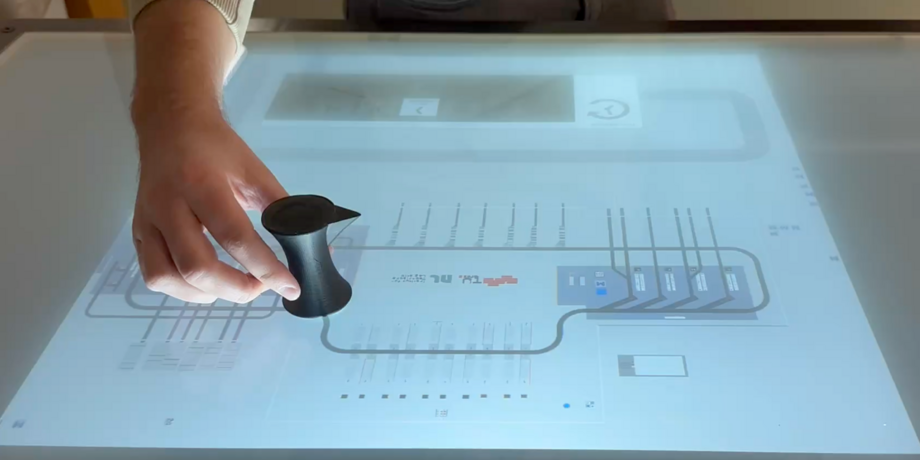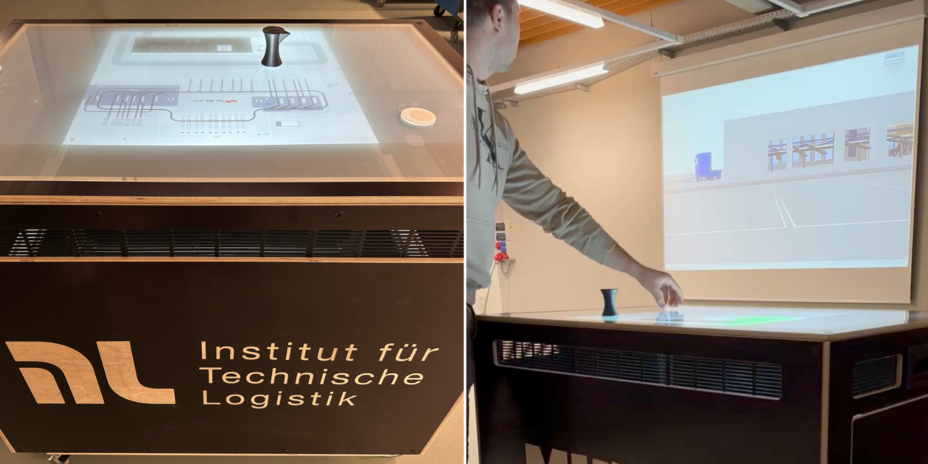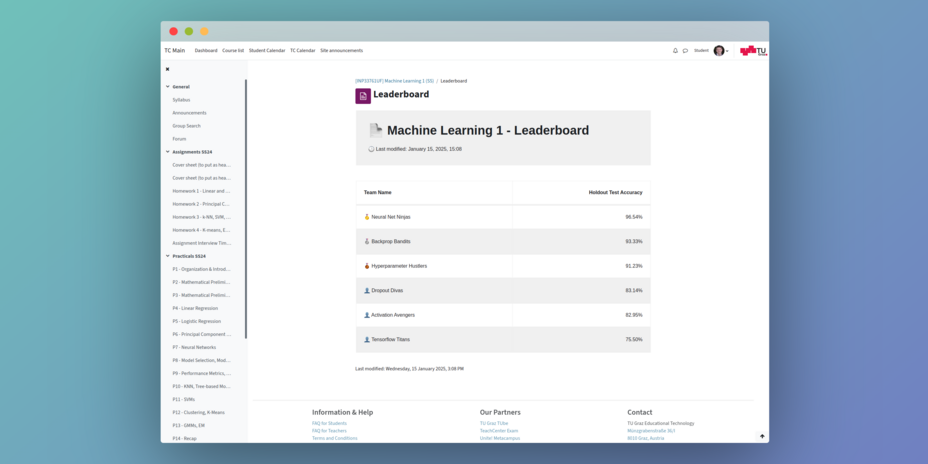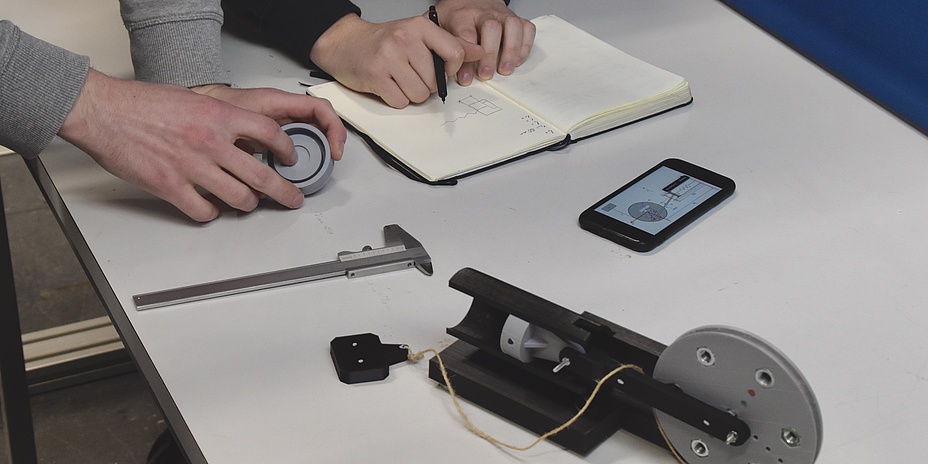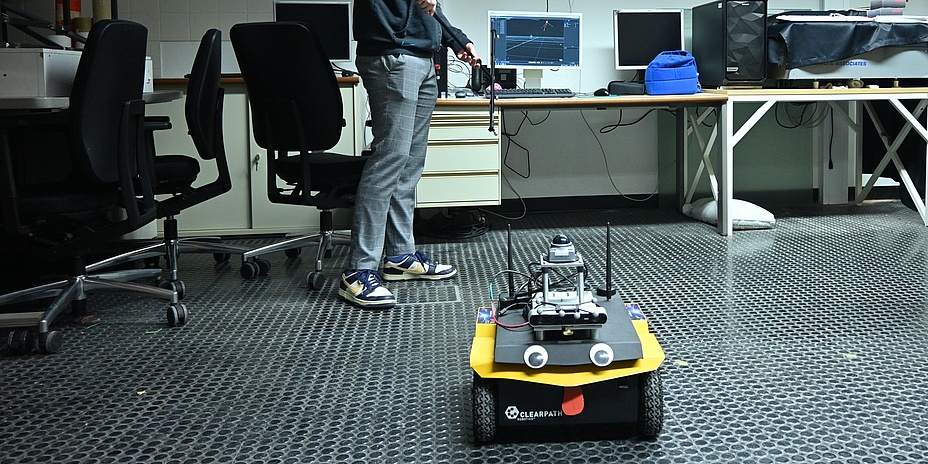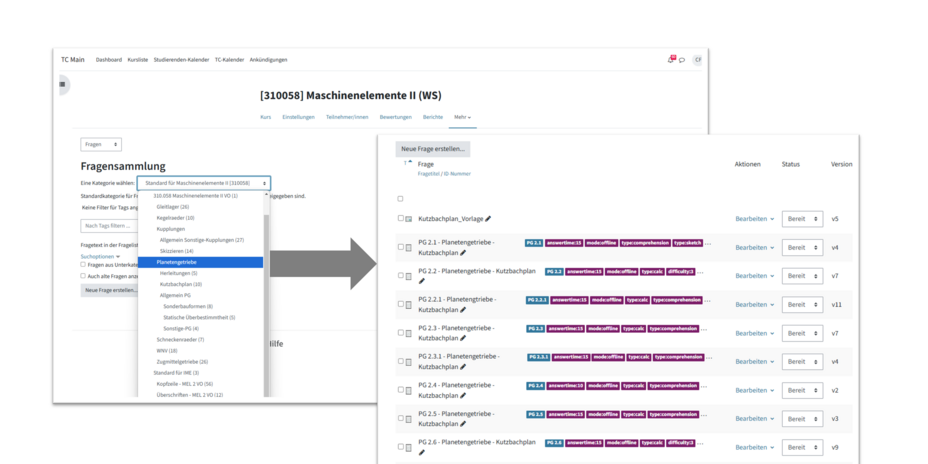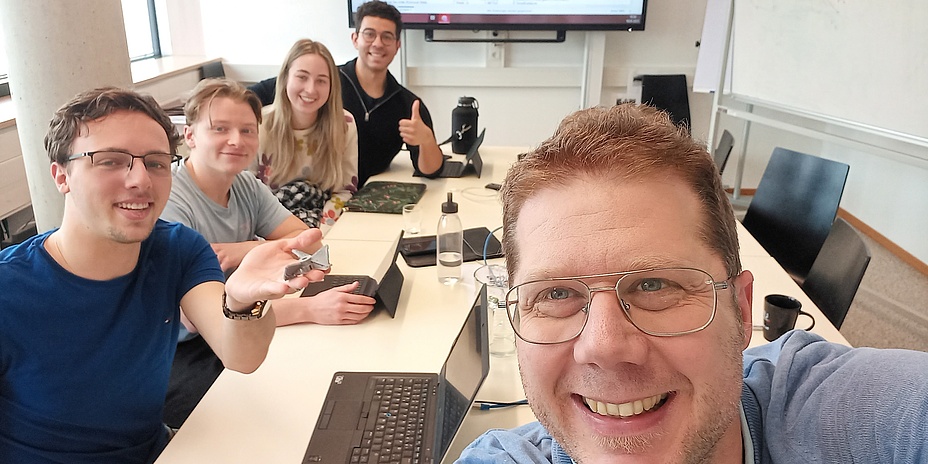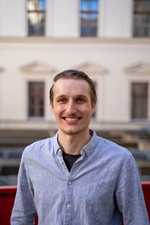A large number of projects were once again submitted to the "Project fund for teaching" in 2024, 14 of which were eventually funded. Read more about the innovative projects that are being implemented in a wide variety of settings here.
The project fund has been tendered once a year since 2020. It was already apparent back then that there are many ideas in teaching that can be implemented with a limited budget and can have great benefits. The pool of ideas grew significantly between 2020 and the 5th call for proposals in 2024: While 19 submissions were counted in the first year, by 2024 there were as many as 34. Over €300,000 in funding was distributed in the first 5 years.
Up to €7,500 per project with a total funding volume of €75,000 could be applied for in 2024.
A competitive call for proposals also means that only a limited number of applications can be funded. Which applications in this round particularly impressed the selection committee, consisting of the Vice Rector for Academic Affairs, Stefan Vorbach, and members of the Steering Group Didactics, made up of representatives from the organisational units of the Vice Rectorate for Academic Affairs? We present the projects to you.
The 2024 funding can be roughly divided into approaches that involve students actively engaging with AI, software or hardware solutions and the adaptation/renewal of teaching concepts (e.g. development of new exercise examples). The winners are listed below in alphabetical order per chapter.
Treatment and use of AI in teaching
Christopher Albert, course "Programming in Physics": By funding a student assistant and high-performance hardware, a "user-friendly AI code assistant solution based on large language models" (translated quote from the project fund application) is to be created. Students should therefore consciously use AI for coding itself and for debugging code. This will teach them how AI can be used profitably in the field of programming. It should also be emphasised that the learning platform used, the plug-ins developed and content publications are made freely available as Creative Commons.
Florian Unger, courses "Data Structures and Algorithms 1" and "Theoretical Computer Science" (Theoretische Informatik): When and how do LLMs reach their limits? The views of students and researchers seem to differ here. According to Florian Unger, discussions in courses give rise to the suspicion that students sometimes assume that AI can easily complete exercises and that their own work is becoming increasingly obsolete. For this reason, future assignments created with the help of student assistants using ChatGPT or comparable systems should encourage students to engage with LLMs. For example, students must identify LLM-generated answers as such or convert existing tasks that can be solved by LLMs in such a way that they can no longer be solved by them in the end.
Don't ban AI in study programmes, but show possibilities and limits through targeted use: this is the motto of the two Project Fund 2024 submissions that deal with the topic.
Software solutions
Domenik Kaever, course "Selected Chapters in Logistics Engineering": Driverless transport systems have become an integral part of logistics. With the acquisition of the "Edddison" demonstrator, supported by the project fund, students will in future have the opportunity to experience the digital twin of logistics systems and witness the effect of optimisations in three dimensions. In conjunction with a camera and projection system, with self-made components from the 3D printer and add-on parts made of wood as a new, innovative material for the construction of sustainable test benches, students can, for example, virtually immerse themselves in the operation of a parcel distribution centre and watch the parcels being sorted by man and machine. This additional dimension of the digital twin provides access to complex logistics systems in a fun way. The interactive 3D application can be used without any programming knowledge, which also enables playful use in the "MINKT Labor" (STEAM laboratory, Website in German) for children and young people.
Yannic Maus and Birgit Vogtenhuber, course „Design and analysis of algorithms”: As the course progresses, the complexity of the content often increases. Yannic Maus and Birgit Vogtenhuber therefore divide the exercises for analysing and developing algorithms in their course into three levels of increasing complexity. In response to course evaluations, an increased focus is placed on basic Level 1 examples in order to provide students with a sound basis for solving more complex Level 2 and Level 3 examples. With the support of a student assistant, a TeachCenter solution is programmed that generates automated Level 1 examples, autonomously evaluates students' solutions and provides feedback on them.
Thomas Wedenig, course „Machine Learning 1”: So far, the results of the tasks in the exercise have been discussed using a report and the underlying Python code. With the support of a student assistant, a test system including a leaderboard is being developed that students can use to anonymously compare the solutions of their machine learning models with those of fellow students. On the one hand, the test system creates an additional feedback loop that helps participants to find and refine solution strategies. On the other hand, the gamification element of the leaderboard is intended to promote student motivation and commitment.
Hardware solutions
Katrin Ellermann, courses “Multibody Dynamics” (Mehrkörperdynamik) and “Mechatronic Systems” (Mechatronische Systeme): In multibody dynamics, students learn to model the movements of mechanical mechanisms and vehicles and simulate them on the computer. But what use are the best simulation results if they cannot be verified in practice? Several mechanisms were therefore created as 3D prints and fitted with sensors. This allows the movements of a simple real test setup to be compared with the simulation results. The experiments are nevertheless kept so simple that interested students can easily and inexpensively replicate the experiments. In “Mechatronic Systems” (Lecture), students are given the opportunity to carry out their own experiments in small groups with the investments on a voluntary basis and, for example, to check the effect of a sensor change, which was otherwise only demonstrated by the lecturers. In addition to personnel support for preparation, Raspberry Pis, Arduinos and sensors are purchased for various experimental setups and 3D-printed hardware is used.
Jan Carsten Hansen and Christoph Maier, course “Electronic Circuit Design 2”: In the lecture, experiments are usually set up and demonstrated by the teaching staff. This is intended to convey the practical aspect of electronic circuits. A portable lecture hall laboratory with the most important electronic devices (e.g. oscilloscope, function generator, voltage source) will be created for more efficient organization in order to shorten transport times and transport the devices used more safely. The laboratory offers great potential for use in other electrical engineering courses and also for events such as the Open Day of TU Graz. The integrated camera holder furthermore allows the resulting videos to be used as teaching/learning materials in the long term.
Eva Buchmayer and Philipp Berglez, courses “Navigation Systems”, “Integrated Navigation” and “Selected Topics Navigation” (planned): In the courses, students already work with measurement data and develop algorithms for determining position. The results are often difficult for students to interpret and validate if there is no precise reference against which their own solution can be compared. A camera-based tracking system is now being used, which provides exact reference data (position and orientation) for indoor positioning. This enables more in-depth analyses for students and at the same time enhances the explainability of the solutions.
Markus Schuss, course “Microcontroller”: In exercises with large numbers of students, it can be challenging to provide sufficient time and material for all participants to carry out exercises independently. In the “Microcontroller” course, online simulations were recently used for this purpose. In order to make microcontrollers actually feasible for students, a hardware platform is being established with project fund money to provide each student with a set (consisting of a development board, debugger, sensors and actuators) for carrying out exercises from home.
Adaptions and renewals of teaching concepts
Clemens Faustmann, Stefan Kollegger, Philipp Kranabitl and Michael Bader, courses “Machine Elements I” and “Machine Elements II”: Setting up exams which, as in the case of “Machine Elements”, can include knowledge questions, calculation examples, sketching tasks and image interpretations, for example, is a time-consuming process. In recent years, this team of lecturers has therefore developed a collection of exam questions that can be managed in the TeachCenter via the “Exam Printer” and can output an exam at the end with just one click. The plug-in can be used by all teaching staff across TU Graz. In order to ensure quality-assured, widespread use of the exam questions in mechanical engineering, guidelines for creating exams are being developed with student staff support, which ensure that the exams generated from the system have a “necessary degree of variability and at the same time have a comparable scope and level of difficulty” (translated quote from the project fund application).
Christian Landschützer and Stefan Radl, courses “Mechanical Engineering Basics CE I+II”, “Chemical equipment design” (Lecture/Exercise) and “Transport Phenomena”: Five different courses, one common thread: Christian Landschützer and Stefan Radl are testing this concept. For the design and operation of an agitator, as is necessary for the operation of a bioreactor, for example, the mechanical engineering basics are laid in “Mechanical Engineering Basics CE I”, the mechanical design (strength, vibrations) and skills in digital engineering are developed in “Mechanical Engineering Basics CE II”, the process engineering design (selection, flow pattern) in “Chemical equipment design”, and the actual operation is practiced in the laboratory exercise “Transport Phenomena”. Each student takes their respective designs with them to the subsequent courses. In addition to the teaching concept adaptation, CAD/CAE simulation and visualization software as well as a 3D printer are used, with which the agitator is printed and used in an experiment at the end.
Michael Lang, course “Thermodynamics” (Lecture/Exercise/Tutorial/Repetitorium): In order to increase the practical component, hands-on experiments are integrated into the courses in addition to the frontal lecture and the computational application part by integrating thermodynamic teaching aids to visualize the theories shown. Specifically, in addition to personnel support, a laptop for analysis/simulation and experimental setups (e.g. semi-finished products, sensors, fittings) are required to identify subject areas, design suitable experiments, plan/build experimental setups and create accompanying thermodynamic simulations as well as documentation and teaching concepts.
Thorsten Ruprechter and Helmut Leitner, course “Computer Science for Civil Engineering Sciences and Construction Management” (Informatik BW): Programming is not a main part of the Bachelor's degree programme Civil Engineering Sciences and Construction Management, but is promoted in the StEOP course “Informatik BW”. In order to ensure the motivation of non-computer science students, practically applicable content is provided with which this target group can also identify in the context of their subject area. In recent years, a data set freely available via data.gv.at has been used to calculate the costs of refurbishment, new construction and renovation of buildings on Vorarlberg's provincial roads. The outdated data set is to be replaced with a new one that can be used over the coming years and the tasks are to be completely revised with the help of a student assistant accordingly.
Barbara Schuppler, Martin Hagmüller and Franz Pernkopf, course “Speaking and Listening Machines”: The laboratory exercise, carried out for the first time in the summer semester 2025, deals with questions of practical relevance: How can a social robot not only speak intelligibly, but also sound natural? How can machines deal with language that is spoken in a dialect or not in the native language? How can machines deal with language spoken in a noisy environment, e.g. in a bar or canteen? How can machines deal with multiple people talking to them, e.g. in a meeting or in a lecture hall? Over the course of six afternoons, students collect data using experiments to investigate this. In order to prepare the teaching/learning materials for the initial implementation of the laboratory exercise, the project fund will be used to employ student assistants.
In the first five years of the Project Fund for Teaching, total investments of more than €300,000 were supported. There have also been two calls for proposals for larger purchases of teaching infrastructure in recent years.
Further insights
Further photo and video insights can be found in the TU Graz cloud. The more than 30 submissions and 14 presented winners are representative of how diverse and creative teaching is at TU Graz. Innovations in and adaptations of their own courses are on the agenda of many lecturers. The project fund aims to initiate these thought processes and ultimately make it (easier) to implement them with financial resources.
